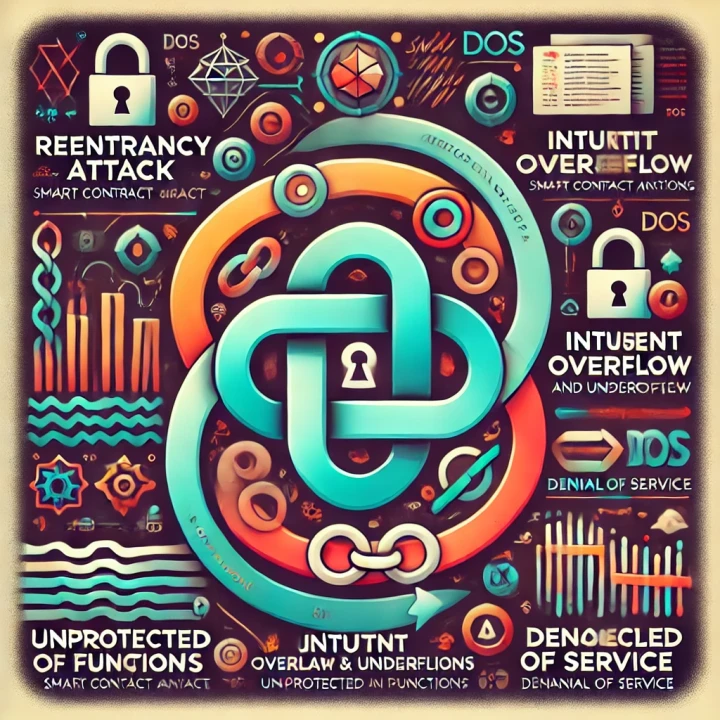
This website uses cookies
We use Cookies to ensure better performance, recognize your repeat visits and preferences, as well as to measure the effectiveness of campaigns and analyze traffic. For these reasons, we may share your site usage data with our analytics partners. Please, view our Cookie Policy to learn more about Cookies. By clicking «Allow all cookies», you consent to the use of ALL Cookies unless you disable them at any time.
Smart contracts have emerged as a cornerstone of blockchain technology, revolutionizing decentralized applications (dApps) by automating contract execution and ensuring trustless interactions. As their adoption grows across various sectors—from finance to supply chain management—their robustness and security become paramount. Understanding and mitigating vulnerabilities in smart contracts are crucial to maintaining the integrity and reliability of blockchain ecosystems.
Overview of Smart Contracts
Smart contracts are self-executing contracts with the terms of the agreement directly written into code. They operate on blockchain platforms, executing autonomously when predefined conditions are met. This eliminates the need for intermediaries, reduces transaction costs, and enhances transparency and efficiency in transactions.
Common Types of Smart Contract Vulnerabilities
Reentrancy Attacks
Reentrancy occurs when a function within a smart contract can be called recursively before the previous invocation completes. This vulnerability gained infamy during the DAO hack in 2016, where an attacker exploited reentrancy to drain funds from the DAO smart contract. Developers can prevent reentrancy by ensuring that state changes precede external function calls, using mutex locks, and implementing withdrawal patterns that prioritize security over gas efficiency.
Integer Overflow and Underflow
Integer overflow and underflow vulnerabilities arise from improper handling of arithmetic operations within smart contracts. These vulnerabilities can lead to unexpected behaviors, such as wrapping values or erroneous calculations, potentially compromising contract security. Best practices include using safe arithmetic libraries, checking boundary conditions, and employing explicit type definitions to prevent unintended overflow and underflow scenarios.
Unauthorised Operations
Unauthorised operations stem from poorly implemented access control mechanisms within smart contracts. Unprotected functions or incorrect permission settings can allow unauthorised users to execute critical operations, compromising data integrity and financial assets. Developers mitigate this risk by implementing role-based access control (RBAC), enforcing authorisation checks in critical functions, and using modifiers to restrict function access based on user roles.
Front-Running Attacks
Front-running occurs when an attacker exploits the predictability of blockchain transaction order to manipulate contract execution for personal gain. In decentralized exchanges (DEXs) and token swaps, front-running can lead to unfair trades or inflated transaction costs. Mitigation strategies include using commit-reveal schemes, batching transactions, and leveraging decentralised order book designs to reduce the impact of transaction ordering vulnerabilities.
Timestamp Dependence
Smart contracts relying on block timestamps for time-dependent operations are vulnerable to manipulation and inaccuracies. Attackers can exploit delays in block propagation or manipulate timestamps to influence contract outcomes, such as auction endings or token vesting schedules. Alternative approaches involve using trusted external time sources (oracles), block number comparisons for time calculations, or using relative time frames instead of absolute timestamps to minimise risks associated with timestamp dependence.
Denial-of-Service (DoS) Attacks
DoS attacks target smart contracts by overwhelming them with malicious requests or computations, causing network congestion or contract unresponsiveness. Attackers exploit inefficiencies in contract logic or external dependencies to exhaust resources and disrupt service availability. Strategies for resilience include optimizing gas usage, setting gas limits for critical operations, and implementing circuit breakers or rate limiters to mitigate potential DoS vulnerabilities.
Tools and Techniques for Detecting Vulnerabilities
Auditing smart contracts is essential to identify and rectify vulnerabilities before deployment. Automated tools such as MythX, Securify, and Slither analyze contract code for common vulnerabilities, while manual code reviews by security experts ensure thorough inspection of complex logic and edge cases. Case studies highlight successful vulnerability detection and remediation, emphasising the importance of integrating security audits throughout the development lifecycle.
Best Practices for Secure Smart Contract Development
Developers engaging in smart contract development are tasked with not only delivering functional code but also ensuring robust security measures are in place to protect user assets and uphold the integrity of decentralised applications (dApps). The following best practices are essential guidelines for mitigating vulnerabilities and enhancing the security posture of smart contracts:
Adhere to Established Standards and Practices
Recommendation: Smart contracts often implement standardised interfaces and best practices defined by frameworks like Ethereum's ERC standards (e.g., ERC-20 for fungible tokens, ERC-721 for non-fungible tokens). Adhering to these standards not only ensures interoperability with existing blockchain infrastructure but also incorporates community-vetted security considerations.
Implementation: Developers should thoroughly understand the specific ERC standard relevant to their application and follow implementation guidelines to minimize implementation errors and security vulnerabilities.
Comprehensive Testing and Auditing
Recommendation: Rigorous testing is indispensable in identifying and mitigating vulnerabilities before deployment. Test suites should encompass unit testing, integration testing, and fuzz testing to validate contract functionality under various conditions.
Implementation: Automated testing frameworks like Truffle Suite and hardening tools such as MythX and Securify can automate vulnerability detection. Manual code reviews by security experts and community audits complement automated tools to identify complex logic errors and edge-case vulnerabilities.
Secure Coding Practices
Recommendation: Adopting secure coding practices is crucial in mitigating vulnerabilities such as reentrancy, integer overflow/underflow, and unauthorised operations. Practices include using safe arithmetic libraries, enforcing input validation, and minimising reliance on external data sources.
Implementation: Developers should employ explicit type definitions, validate input parameters, and utilise libraries that provide built-in security features (e.g., OpenZeppelin for reusable, audited smart contract libraries). Documenting security considerations within code comments enhances transparency and facilitates future audits and maintenance.
Access Control and Permissions
Recommendation: Implement robust access control mechanisms to restrict privileged operations to authorised users only. Role-based access control (RBAC) patterns ensure that critical functions are accessible only to designated administrators or contract owners.
Implementation: Use modifiers to enforce access control logic in smart contracts, validate sender addresses against predefined roles or permissions, and consider multi-signature schemes for sensitive transactions requiring consensus among multiple parties.
Gas Optimization and Limitations
Recommendation: Efficient gas usage not only reduces transaction costs but also mitigates the risk of Denial-of-Service (DoS) attacks targeting smart contracts. Optimizing gas consumption involves prioritising computational efficiency and minimising storage requirements.
Implementation: Employ gas limit estimations for critical operations, prioritise computations off-chain where feasible, and utilise gas-efficient coding patterns (e.g., batch processing, state channels) to streamline contract execution and conserve network resources.
Continuous Security Updates and Community Collaboration
Recommendation: Smart contract security is an evolving field, necessitating proactive measures to address emerging threats and vulnerabilities. Engaging in community-driven security audits, participating in bug bounty programs, and maintaining open communication channels foster a collaborative approach to security.
Implementation: Regularly update smart contracts to incorporate security patches and improvements, adhere to blockchain platform updates and security advisories, and contribute to discussions on security forums and developer communities to stay abreast of best practices and emerging trends.
Conclusion
Secure smart contract development is foundational to maintaining trust, reliability, and resilience in decentralised applications. By adhering to established standards, conducting comprehensive testing and audits, employing secure coding practices, implementing robust access controls, optimising gas usage, and fostering ongoing security updates and community collaboration, developers can effectively mitigate vulnerabilities and safeguard blockchain ecosystems. Prioritizing security in smart contract development not only protects user assets but also promotes innovation and confidence in the transformative potential of blockchain technology.



